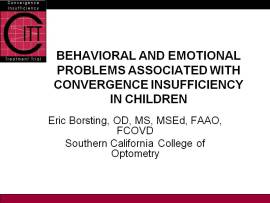Vision and Learning
New research shows evidence – Emotional and ADD-like behavior problems in children linked to common
Dan L. Fortenbacher, O.D., FCOVD

 A team of researchers have recently released the results of a new study that shows a strong connection linking Convergence Insufficiency (CI), a relatively common binocular vision problem, with ADD/ADHD behaviors and emotional problems.
A team of researchers have recently released the results of a new study that shows a strong connection linking Convergence Insufficiency (CI), a relatively common binocular vision problem, with ADD/ADHD behaviors and emotional problems.
Even though Convergence Insufficiency (CI) has been extensively researched over the last 10 years this additional research is an important piece in the research puzzle to help doctors understand the impact ofConvergence Insufficiency (CI) on the quality of life of patient. Dr. Press and I have written on several previous VisionHelp Blog posts beginning with CI- The Private Eye Goes Public – Part 1, where the epidemiological research shows the prevalence of CI to be about 1 in 12 in pediatric populations. Additionally, we know that CI is associated with eye strain, double vision, headaches, blurred vision and other symptoms that can be found on the Convergence Insufficiency Symptom Survey (CISS). And we have definitive research that shows the only mode of treatment proven effective for CI is office-based vision therapy.
But, even though most doctors in the field of developmental vision and vision therapy will acknowledge that they regularly see ADD-like behaviors and emotional problems in the children we treat with CI; there has not been any definitive research that targeted these specific symptoms, eg. having poor attention and concentration, loss of self-esteem, depression, anxiousness, withdrawn and somatic complaints…until now!
What’s more, this study validated what we in the field have seen in our patients, that is, when Convergence Insufficiency is properly treated with office based vision therapy, these childr en showed statistically signficant improvement in their attention and concentration on the Connors Rating Scale as well as a signficant reduction in internalized and somatic emotional problems as measured on the Child Behavior Checklist (CBCL). A special word of thanks to lead author, Dr. Eric Borsting for making available to the VisionHelp Blog their team’s (pre-manuscript) findings that have been organized into a PowerPoint presentation. To see the details you can download the pdf version of the findings click here:
en showed statistically signficant improvement in their attention and concentration on the Connors Rating Scale as well as a signficant reduction in internalized and somatic emotional problems as measured on the Child Behavior Checklist (CBCL). A special word of thanks to lead author, Dr. Eric Borsting for making available to the VisionHelp Blog their team’s (pre-manuscript) findings that have been organized into a PowerPoint presentation. To see the details you can download the pdf version of the findings click here:
Given that CI affects over 20 million people in the US alone, and now that we see clear evidence from this study that there is indeed a linkage with behavioral and emotional problems found in children should make this a top priority in advocacy for children’s health issues.
But, one of the major obstacles in public awareness of Convergence Insufficiency is that this condition is clearly not a household word. Parents whose school-age child is newly diagnosed with CI frequently will ask, “Why did no one recognize this in my child earlier?” To address this common question, our office has produced a video, entitled:Looking Inward: The Vision Therapy Treatment of Convergence Insufficiency to help bring about a better understanding for diagnosis and effective treatment of this common and yet potentially disabling vision problem, due to the emotional and behavioral side effects of Convergence Insufficiency.